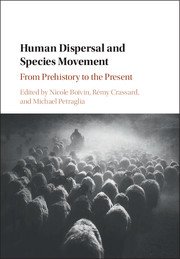Book contents
- Frontmatter
- Contents
- List of text boxes
- List of figures
- List of tables
- List of contributors
- Preface
- I Introduction
- II Origins: Species Movements in the Pleistocene
- III Across the water: Species movements by Coast and Sea
- IV Complexity: Species Movements in the Holocene
- 9 Dispersals, connectivity and indigeneity in Arabian prehistory
- 10 Reconstructing migration trajectories using ancient DNA
- 11 Out of the Fertile Crescent: The dispersal of domestic livestock through Europe and Africa
- 12 Adapting crops, landscapes, and food choices: Patterns in the dispersal of domesticated plants across Eurasia
- 13 Tracing the initial diffusion of maize in North America
- 14 Proto-globalisation and biotic exchange in the Old World
- V Invasion: The Movement of Invasive and Disease Species
- Index
- Plate section
- References
10 - Reconstructing migration trajectories using ancient DNA
from IV - Complexity: Species Movements in the Holocene
Published online by Cambridge University Press: 04 May 2017
- Frontmatter
- Contents
- List of text boxes
- List of figures
- List of tables
- List of contributors
- Preface
- I Introduction
- II Origins: Species Movements in the Pleistocene
- III Across the water: Species movements by Coast and Sea
- IV Complexity: Species Movements in the Holocene
- 9 Dispersals, connectivity and indigeneity in Arabian prehistory
- 10 Reconstructing migration trajectories using ancient DNA
- 11 Out of the Fertile Crescent: The dispersal of domestic livestock through Europe and Africa
- 12 Adapting crops, landscapes, and food choices: Patterns in the dispersal of domesticated plants across Eurasia
- 13 Tracing the initial diffusion of maize in North America
- 14 Proto-globalisation and biotic exchange in the Old World
- V Invasion: The Movement of Invasive and Disease Species
- Index
- Plate section
- References
Summary
Abstract
Revealing the temporal and geographic pattern of human and animal dispersal and migration has been a major goal within anthropology, archaeology, and palaeontology. Here, I focus on the use of ancient DNA to delve beneath the migration palimpsests. More specifically, I firstly describe the use of ancient DNA derived from archaeological pig remains as a proxy to understand the initial dispersal of farmers into Europe, the back migration into Anatolia, and the spread of people into the Pacific. I then show how ancient DNA from foxes in the northern and southern hemisphere has been used to understand their dispersal onto islands in the absence of landbridges. These case studies highlight the value of DNA derived from long-dead organisms to detail the pattern and process of ancient dispersals.
Keywords: Domestication, pigs, Arctic fox, long-distance dispersal, Lapita dispersal
INTRODUCTION
Tracing the timing and trajectories of human and animal migratory patterns has been a significant anthropological, archaeological, and palaeontological endeavour. In order to piece together the palimpsest of migrations, scientists have employed a range of proxies including not only genetic signatures and fossil and sub-fossils evidence, but also, in the case of people, linguistics and material culture (see Boivin, Introductory chapter). More recently, the ability to extract and sequence DNA from ancient organismal remains has allowed researchers to directly observe molecular patterns of variation in time and space, thus adding an important temporal perspective to migration-related questions.
Ancient DNA (aDNA) refers to the retrieval and amplification of DNA fragments from organisms that are no longer alive. Like the organism itself, the DNA contained within it begins degrading as soon as it dies. Inevitably, the DNA disappears completely, though the rate at which this occurs can be slow enough to allow for its retrieval and sequencing depending on the preservation conditions (Allentoft et al., 2012). Because each individual cell of any organism contains a full copy of that individual's entire genome, and several thousand copies of the individual's mitochondrial genome, aDNA has been retrieved not just from the obvious remains such as bones, teeth, and tissue, but also from less obvious sources such as hair, coprolites, and even frozen mud, where DNA remained despite the lack of any physical remains (Shapiro and Hofreiter, 2012).
- Type
- Chapter
- Information
- Human Dispersal and Species MovementFrom Prehistory to the Present, pp. 237 - 260Publisher: Cambridge University PressPrint publication year: 2017
References
- 4
- Cited by



